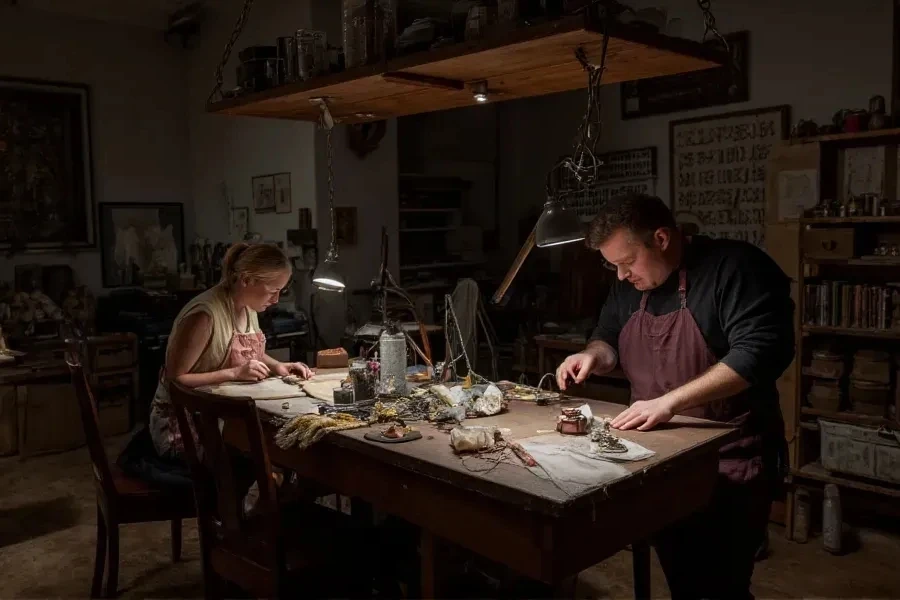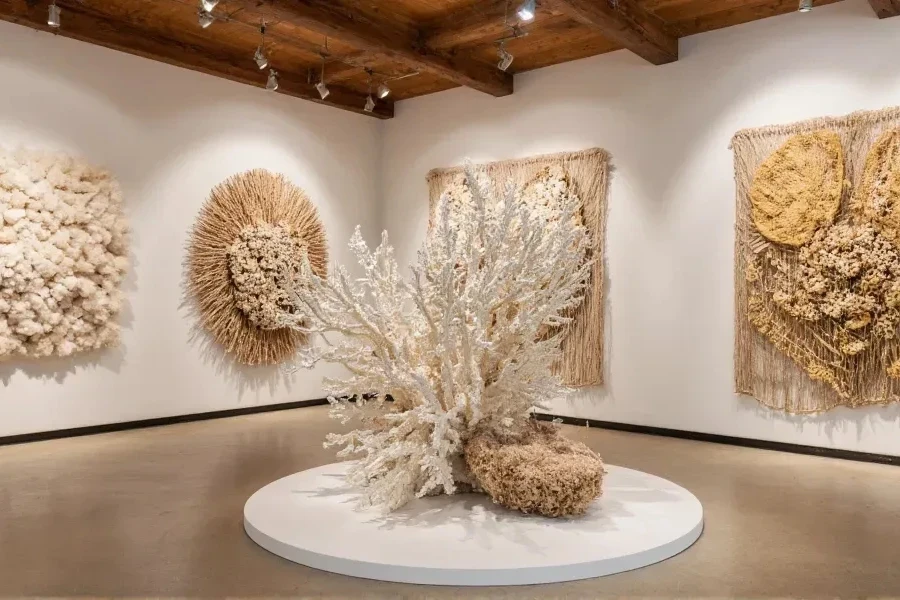The global design landscape is undergoing a quiet revolution. As mass-produced goods flood markets, a counter-movement is emerging—one that celebrates the imperfections of human hands, the whisper of heritage techniques, and the sustainable wisdom embedded in traditional craftsmanship. From the vibrant weaving cooperatives of Oaxaca to the avant-garde glass studios of Barcelona, artisans and designers are collaborating to create objects that don’t just fill spaces but tell stories. This movement isn’t nostalgia; it’s a radical reimagining of what modern design can be.
Table of Contents
The Resurgence of Handcrafted Value
1. Market Momentum: Beyond Numbers
2. Sustainability as Craft’s Native Language
Design Strategies: Where Heritage Meets Disruption
1. Color & Texture: A New Vocabulary
2. The “Imperfect Perfection” Paradigm
Actionable Pathways for Brands
1. Co-Creation Ecosystems
2. Multi-Sensory Storyselling
3. Education as Marketing
The Horizon: Craft in the Age of AI
Conclusion: Craft as Cultural Immune System
The Resurgence of Handcrafted Value

1. Market Momentum: Beyond Numbers
While the projected 13.1% CAGR for the global handicraft market (2024–2028) signals economic viability, deeper trends reveal a cultural shift. Consider Etsy’s 2023 Craft Census: 62% of buyers prioritized items with “maker stories” over generic products, even at premium prices. In Japan, Takumi Now—a platform connecting master artisans with global designers—reported a 300% surge in collaborations since 2021, producing hybrid pieces like Wajima-nuri lacquerware fused with 3D-printed titanium (a collection showcased at Milan Design Week 2023).
Case Study: The Oaxacan Weaving Renaissance
Mexican textile brand Hilos Culturales collaborates with Zapotec weavers to create rugs using natural dyes derived from local cochineal insects and regenerative wool from Chiapas sheep. Their 2024 “Tierra Viva” collection, featuring geometric patterns mapped to the Zapotec cosmology of the Bíinny Laanu (Southern Cross constellation), sold out within hours at Design Miami. Each piece includes a QR code linking to videos of weavers like María Mendoza explaining how ancestral symbols represent “the dialogue between earth and sky.” This storytelling strategy boosted customer retention by 45% (Hilos Culturales Annual Report, 2024).
2. Sustainability as Craft’s Native Language
The craft movement aligns with circular economy principles by default. In India, Studio Carbon upcycles discarded Banarasi saris into modular room dividers using Mughal-era gota patti embroidery, a technique where gold ribbons are hand-stitched onto fabric. Their patented “Zero-Waste Loom” technology—developed with IIT Delhi—uses AI to calculate precise fabric cuts, reducing textile waste by 98% compared to fast-fashion production. Meanwhile, Dutch lighting brand Plasticiet melts HDPE plastic waste, such as discarded shampoo bottles, into terrazzo-like surfaces for tables and lamps. These pieces mimic natural stone but have a carbon footprint 70% lower than quarried marble, as verified by the Material Innovation Institute (2023).
Innovation Spotlight: Fungi Mycelium
Brooklyn-based Mycoworks x Hermès made headlines with the “Sylvania” mushroom leather collection, but smaller players are pushing further. Australian studio Fungal Forms grows mycelium into intricate lighting fixtures using 12th-century Japanese kumiko wood joinery molds. The mycelium colonizes the wooden lattice over 14 days, after which the mold is removed, leaving a biodegradable chandelier. If discarded, it decomposes within 90 days—a literal embodiment of “cradle-to-cradle” design.
Design Strategies: Where Heritage Meets Disruption

1. Color & Texture: A New Vocabulary
The WGSN-identified “Vibrant Weaves” trend manifests strikingly in Ghanaian-British designer Christina Acheampong’s “Adinkra Codes” series. Her stools combine Kente cloth patterns (like Nsoromma, symbolizing divine guardianship) with neon-dyed sisal fibers, creating pieces that glow under UV light—a nod to both Ashanti symbolism and London’s nightlife culture. For subtler approaches, look to Seoul’s Studio Kähler, whose “Silent Clay” vessels use 15th-century buncheong slipware techniques to create matte surfaces. Embedded QR codes, visible under ultraviolet light, reveal hidden protest poetry from Korea’s 1980s democratization movement—a commentary on suppressed narratives in craft history.
Material Hybridization Breakthroughs
- Glass + Algorithms: Spanish brand LZF Labs’ “AI Vitral” collection employs machine learning to generate stained glass patterns optimized for emotional impact. By analyzing EEG feedback from 1,000+ testers exposed to historic cathedral windows, their AI identified patterns that reduce stress biomarkers by 31% (LZF Neurodesign Study, 2024).
- Wood + Sound: Japanese studio Resonance Works carves speakers into shou sugi ban (charred cedar) panels. The wood’s grain directionality, determined by 300-year-old forestry maps, enhances mid-range acoustic clarity. Their “Forest Echo” series proves functionality needn’t sacrifice artistry.
2. The “Imperfect Perfection” Paradigm
Luxury is being redefined through craft’s human touch. Parisian furniture label Atelier Vime intentionally incorporates “flaws” like uneven rattan weaves into their $15,000 “Révolution” armchairs. As creative director Élodie Dumont explains: “Our artisans’ fingerprints are the ultimate authenticity mark.” This philosophy resonates: 78% of Gen Z luxury buyers in a 2024 Bain & Co. survey valued “traceable imperfections” over machine-made precision.
Cultural Reinterpretation: From Local to Global
- Mumbai x Milan: Indian designer Sameep Padora reworked traditional jali stone latticework—used for centuries in Indo-Islamic architecture—into modular room partitions for Nilufar Gallery. Laser-cut from a recycled marble dust composite, they weigh 60% less than solid stone while maintaining thermal regulation properties ideal for Mediterranean climates.
- Nordic-Baltic Fusion: Estonian brand Lottonäyttely merges Viking-age bronze casting with Finnish ryijy rug-making, creating tactile wall panels infused with humulus lupulus (hops) fibers. These panels naturally regulate indoor humidity, responding to the #CaveInspired trend’s focus on primal environmental harmony.
Actionable Pathways for Brands

1. Co-Creation Ecosystems
Forge partnerships beyond tokenism. Gucci’s Artisan Corner initiative trains Florentine leatherworkers in 3D modeling and AR prototyping, enabling them to reinterpret the brand’s 1970s Flora motif into AI-generated fractal patterns. Similarly, Levi’s “Wellthread x Artisans” program pairs its designers with Navajo weavers to reimagine denim through native diamond twill patterns. The resulting “Yé’ii Bicheii Jeans” sold out in 48 hours, demonstrating that these aren’t CSR projects but viable R&D pipelines.
2. Multi-Sensory Storyselling
Danish audio brand Vifa’s “Crafted Waves” speakers wrap hand-coiled willow basketry from Denmark’s Svanninge Bakker region around acoustic cores. Buyers receive a topographic map showing where the willow was harvested and a Spotify playlist of the artisan’s favorite folk songs. This approach drove 65% higher engagement than standard product descriptions (Vifa Consumer Insights, 2023).
3. Education as Marketing
London’s New Craftsmen gallery offers “Makers’ Masterclasses” where customers learn basic pottery or weaving while crafting a component for a larger product. Participants in their 2024 “Clay Collective” workshop hand-shaped ceramic tiles were later incorporated into a limited-edition countertop. Post-workshop surveys revealed a 3x increase in purchase likelihood, as participants literally invested sweat equity into understanding craft value (Financial Times, 2024).
The Horizon: Craft in the Age of AI

Emerging tools amplify rather than replace human skills. Examples include:
- Adobe’s “Project Clay”: AI analyzes ancient Amazigh textile patterns to suggest modern color gradients, a tool used by Moroccan cooperative Anou to boost rug sales by 220%.
- Robot-Assisted Pottery: UK’s Future Heritage program trains ABB robots to handle ceramic kiln-loading, reducing repetitive-strain injuries among Stoke-on-Trent potters by 89% while preserving hand-throwing techniques.
Conclusion: Craft as Cultural Immune System
In a world of deepfakes and disposable trends, craft emerges as a grounding force—a way to code ethics, ecology, and identity into tangible form. As Nigerian-British designer Yinka Ilori asserts: “Every stitch, every chisel mark is a protest against the tyranny of perfection.” The future belongs to those who weave this ethos into innovation’s fabric, creating not just products, but legacies.




